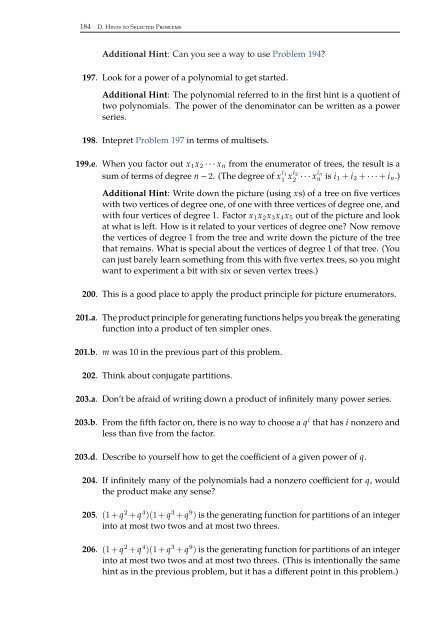Combinatorics Through Guided Discovery, 2004a
Combinatorics Through Guided Discovery, 2004a
Combinatorics Through Guided Discovery, 2004a
You also want an ePaper? Increase the reach of your titles
YUMPU automatically turns print PDFs into web optimized ePapers that Google loves.
184 D. Hints to Selected Problems<br />
Additional Hint: Can you see a way to use Problem 194?<br />
197. Look for a power of a polynomial to get started.<br />
Additional Hint: The polynomial referred to in the first hint is a quotient of<br />
two polynomials. The power of the denominator can be written as a power<br />
series.<br />
198. Intepret Problem 197 in terms of multisets.<br />
199.e. When you factor out x 1 x 2 ···x n from the enumerator of trees, the result is a<br />
sum of terms of degree n − 2. (The degree of x i 1<br />
1<br />
x i 2<br />
2 ···x i n<br />
n is i 1 + i 2 + ···+ i n .)<br />
Additional Hint: Write down the picture (using xs) of a tree on five vertices<br />
with two vertices of degree one, of one with three vertices of degree one, and<br />
with four vertices of degree 1. Factor x 1 x 2 x 3 x 4 x 5 out of the picture and look<br />
at what is left. How is it related to your vertices of degree one? Now remove<br />
the vertices of degree 1 from the tree and write down the picture of the tree<br />
that remains. What is special about the vertices of degree 1 of that tree. (You<br />
can just barely learn something from this with five vertex trees, so you might<br />
want to experiment a bit with six or seven vertex trees.)<br />
200. This is a good place to apply the product principle for picture enumerators.<br />
201.a. The product principle for generating functions helps you break the generating<br />
function into a product of ten simpler ones.<br />
201.b. m was 10 in the previous part of this problem.<br />
202. Think about conjugate partitions.<br />
203.a. Don’t be afraid of writing down a product of infinitely many power series.<br />
203.b. From the fifth factor on, there is no way to choose a q i that has i nonzero and<br />
less than five from the factor.<br />
203.d. Describe to yourself how to get the coefficient of a given power of q.<br />
204. If infinitely many of the polynomials had a nonzero coefficient for q, would<br />
the product make any sense?<br />
205. (1 + q 2 + q 4 )(1 + q 3 + q 9 ) is the generating function for partitions of an integer<br />
into at most two twos and at most two threes.<br />
206. (1 + q 2 + q 4 )(1 + q 3 + q 9 ) is the generating function for partitions of an integer<br />
into at most two twos and at most two threes. (This is intentionally the same<br />
hint as in the previous problem, but it has a different point in this problem.)


















